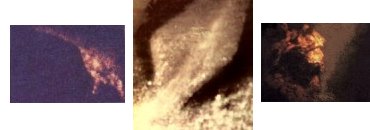

The Rines photographs were eagerly received by the world's media and headline writers had a field day. Here at last was the proof that Nessie really did exist! Soon there was talk of another expedition, this time with the objective of capturing Nessie. Given the stature of Rines and Scott (Rines was the incumbent President of the Academy of Applied Science and Scott was Honorary Chairman of the World Wildlife Council International), it really did appear that the mystery was solved. Amid the welter of publicity, Sir Peter Scott took the unprecedented step of according Nessie a scientific name, "Nessiterras Rhombopteryx" but herein may lie the sting. Though it may just be one of life's amazing coincidences, the name Nessiterras Rhombopteryx just happens to be an anagram of the phrase monster hoax by Sir Peter S!
More than two decades on, no evidence has emerged to confirm the probity of the Rines photographs which is rather odd if they were in fact genuine. The sceptics will doubtless see the anagramatical message contained in the name Nessiterras Rhombopteryx as proof that Rines and Scott were, like Dr Robert Wilson 40 years earlier, just hoaxers. It is surely asking too much of coincidence to believe that Scott's generic name for Nessie is simply a cryptological accident? Oddly, however, such cryptological accidents do occur. It is after all mere coincidence that the word "schoolmaster" just happens to be an anagram of "the classroom"!| the loch ness story | ||||||||||||
Loch Ness is a magnificent freshwater lake that stretches some 24 miles along the Great Glen geological fault line from Inverness to Fort Augustus. Quite apart from its breathtaking beauty, Loch Ness is something of an enigma in that it is reputedly the home of "Nessie", the Loch Ness Monster! As with most controversies, opinions are sharply divided on the question of "Nessie's" existence. There is a body of anecdotal evidence that points strongly towards the conclusion that Loch Ness does indeed harbour an an unidentified creature of considerable size and this is supported by some dubious, but nevertheless fascinating, photographic evidence. In 1934, the eminent Harley Street physician Colonel Robert Wilson produced his now infamous "surgeon's photograph", purporting to show the head and neck of a creature resembling a plesiosaurus. In the ensuing years, the Wilson photograph remained the most enduring piece of "hard" evidence pointing to the existence of a monster within the dark depths of Loch Ness. This situation prevailed until 1994 when 90 year-old Christian Spurling, Wilson's stepson, made a startling deathbed confession.
|
|
|
A Plesiosaur Sporadic sightings continued until the 1930's when the new road alongside Loch Ness was built. From this time on, sightings become more frequent as one might expect given the increased volume of potential observers. Sceptics have long dismissed the Nessie sightings as a ploy to attract tourists to the area but two points need to be made here. First, there was no organised tourist trade to speak of prior to the late 1950's. Perhaps more significantly, most of the sightings of Nessie before the 1950's were made by local people. Hoaxing is not an activity one would immediately associate with the average highlander of the time. Indeed the only hoax exposed from this period was the one perpetrated by Londoner Colonel Robert Wilson and his cynical cronies. Although conventional science has largely shunned investigation of the Loch Ness monster phenomenon, there have been a few notable exceptions. In the mid 70's, the late naturalist and Knight of the Realm Sir Peter Scott joined Dr Robert Rines of the Academy of Applied Sciences of Boston, Massachusetts on an investigation which gained worldwide publicity. Using the very latest underwater photographic techniques, Scott and Rines explored the peat-blackened depths of the loch searching for the "snapshot" of a lifetime. Much to the relief of the expedition sponsers, photographs of the elusive Nessie were soon forthcoming. Though lacking definition, the Rines' photographs were of sufficient clarity to show what appeared to be a large creature similar to a Plesiosaurus with diamond shaped fins. | |||||||||
| Copyright Isaac Blonder
© 1998- 2025
Questions on this web site? contact webmaster@blonder.com |
||||||||||||